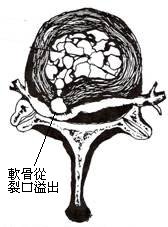
2013-11-27

What is the disc herniation and disc prolapse
Lower back and feet numbness due to disc protrusion are very common. Among the patients I see every day, almost 80% of patients with low back and foot pain are caused by disc protrusion. There are also more cases of disc herniation in the fifth lumbar spine and the first sacrum (called L5/S1 disc).
The structure and function of disc and the symptoms of disc herniation have been discussed many times. Therefore, this article will explain the difference between Disc protrusion or herniation and disc prolapse.
In general, the sciatica caused by both is in the leg and foot, but the symptoms of disc prolapse are more sudden and acute, and the pain is intense than disc protrusion.
Disc is formed by the outer annulus fibrosus (like an onion, layer by layer) and a watery gel-like core of the nucleus pulposus in the inner layer.
Disc protrusion or herniation
Disc protrusion means that the fibrous ring in the outer layer of the disc becomes loose after compression or sudden shock, which causes the inner disc to protrude and presses on the nerve root to cause sciatica.

Disc prolapse
Disc prolapse means that the fibrous ring in the outer layer of cartilage is loosened and tear due to compression or sudden shock, causing some cracks, which can make the inner disc compress the nerve root and cause sciatica.

Sciatica patients suffering from disc prolapse are generally more acute and have more severe symptoms when they wake up in the morning. The patient generally cannot sit for a long time, cannot stand for a long time, and cannot move. When lying down, the thigh is in pain. Because the prolapsed disc contains chemicals, these chemicals can produce extremely high inflammation, causing the compressed nerve roots to increase internal pressure and produce pain.
The protruding disc can press on the inside, outside or center of the nerve root. For example, when pressing to the outside of the nerve root, the patient's body will bend to one side with no foot pain (Figure 3A); when the medial nerve root is pressed, the patient's body will move to the side of the foot pain (Figure 3B); if the nerve is pressed in the middle of the nerve root, the patient's body will lean forward. When a patient comes to see a doctor, doctors can roughly diagnose the patient's condition with the naked eye . Of course, other diagnostic tests are needed to confirm the diagnosis.

X 註明腳痛的一方

 Book an Appointment
Book an Appointment


